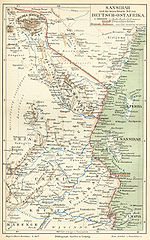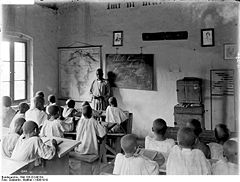- German East Africa
-
Protectorate of German East Africa
Schutzgebiet Deutsch-OstafrikaGerman colony ← 
←
←
1885–1919  →
→
 →
→
 →
→
 →
→

Flag Coat of arms Green: Territory comprising German colony of German East Africa
Dark grey: Other German possessions
Darkest grey: German EmpireNote: The map uses the borders of the present-day, but the historical extent for German territories are depicted.
Capital Bagamoyo (1885–1890)
Dar-es-Salaam (1890–1918)Political structure Colony Emperor - 1871–1888 William I - 1888-1888 Frederick III - 1888–1918 William II Governor - 1885–89 (first) Carl Peters (DOAG) - 1912–18 (last) Heinrich Albert Schnee Historical era New Imperialism - Established 27 February 1885 - Border agreement 1 July - Maji Maji Rebellion 21 October - Surrender to Britain 25 November - Disestablished 28 June 1919 Area - 1913 995,000 km2 (384,172 sq mi) Population - 1913 est. 7,700,000 Density 7.7 /km2 (20 /sq mi) Currency Rupie Today part of  Burundi
Burundi
 Rwanda
Rwanda
 Tanzania
TanzaniaGerman East Africa (German: Deutsch-Ostafrika) was a German colony in East Africa, which included what are now Burundi, Rwanda and Tanganyika (the mainland part of present Tanzania). Its area was 994,996 km2 (384,170 sq mi), nearly three times the size of Germany today.
The colony came into existence during the 1880s and ended with Imperial Germany's defeat in World War I. Afterwards the territory was divided between Britain and Belgium, and was later converted to a mandate of the League of Nations.
Contents
History
The colony began with Carl Peters, an adventurer who founded the "Society for German Colonization" and signed treaties with several native chieftains on the mainland opposite Zanzibar. On 3 March 1885, the German government announced it had granted an imperial charter (issued on 17 February) to Peters' company and intended to establish a protectorate in East Africa. Peters then recruited specialists who began exploring south to the Rufiji River and north to Witu, near Lamu on the coast.
When the Sultan of Zanzibar protested, since he claimed to be ruler on the mainland as well, Bismarck sent five warships, which arrived on 7 August and trained their guns on the Sultan's palace. The British and Germans agreed to divide the mainland between themselves, and the Sultan had no option but to agree.
German rule was quickly established over Bagamoyo, Dar es Salaam, and Kilwa, even sending the caravans of Prince, Langheld, Emin Pasha, Charles Stokes to dominate "the Street of Caravans". The Abushiri Revolt of 1888 and was put down (with British help) the following year. In 1890, London and Berlin concluded the Heligoland-Zanzibar Treaty, returning Heligoland (seized during the Napoleonic wars) to Germany and deciding on the borders of German East Africa (the exact boundaries remained unsurveyed until 1910).
Between 1891 and 1894, the Hehe tribe, led by Chief Mkwawa, resisted German expansion. They were defeated as rival tribes supported the Germans. After years of guerrilla warfare, Mkwawa himself was cornered and committed suicide in 1898.
The Maji Maji Rebellion occurred in 1905 and was put down by the governor, Count Gustav Adolf von Götzen. But scandal soon followed, with stories of corruption and brutality, and in 1907 Chancellor Bülow appointed Bernhard Dernburg to reform the colonial administration. It became a model of colonial efficiency and commanded extraordinary loyalty among the natives during the First World War.
German colonial administrators relied heavily on native chiefs to keep order and collect taxes. By 1 January 1914, aside from local police, military garrisons of Schutztruppen ("protective troops") at Dar es Salaam, Moshi, Iringa, and Mahenge comprised 110 German officers (including 42 medical officers), 126 non-commissioned officers, and 2,472 native enlisted men (Askaris[1]).[2][3]
Paul von Lettow-Vorbeck (served in German South West Africa as well as German Kamerun, and was an important General in German East Africa during World War I.
Economic development
Commerce and growth started in earnest under German direction. Early on it was realized that economic development would depend on reliable transportation. Over 100,000 acres (40,000 ha) were under sisal cultivation – the biggest cash crop. Two million coffee trees were planted and rubber trees grew on 200,000 acres (80,000 hectares ), along with large cotton plantations. To bring these agricultural products to market, beginning in 1888, the Usambara Railway, or Northern Railroad, was built from Tanga to Moshi. The longest line, the Central Railroad covered 775 miles (1,247 km) from Dar es Salaam to Morogoro, Tabora and Kigoma. The final link to the eastern shore of Lake Tanganyika had been completed in July 1914 and was cause for a huge and festive celebration in the capital with an agricultural fair and trade exhibition. Harbor facilities were built or improved with electrical cranes, with rail access and warehouses. Wharves were remodeled at Tanga, Bagamoyo and Lindi. In 1912 Dar es Salaam and Tanga received 356 freighters and passenger steamers and over 1,000 coastal ships and local trading vessels.[4] By 1914 Dar es Salaam and the surrounding province had a population of 166,000, among them 10,490(1,050 Europeans, 1,000 of them Germans. In all of the east African protectorate were 3,579 Germans.[5] In its own right, Dar es Salaam became the showcase city of all of tropical Africa.[6]
Gold mining in Tanzania in modern times dates back to the German colonial period, beginning with gold discoveries near Lake Victoria in 1894. The first gold mine in the colony was the Sekenke Gold Mine, which began operation in 1909 after gold was found there in 1907.[7]
Despite all these efforts, German East Africa never achieved a profit for the German Empire and needed to be subsidized by the Berlin treasury.
Education
Unlike the Belgian, British, French and Portuguese colonial masters in central Africa, Germany developed an educational program for Africans that involved elementary, secondary and vocational schools. "Instructor qualifications, curricula, textbooks, teaching materials, all met standards unmatched anywhere in tropical Africa."[8] In 1924, ten years after the beginning of the First World War and six years into British rule, the visiting American Phelps-Stokes Commission reported: "In regards to schools, the Germans have accomplished marvels. Some time must elapse before education attains the standard it had reached under the Germans."[8]
One of the influences of this German development of education in their colony is the word "shule" (from "schule" in German) that means school. Since Germans were the first colonialists to establish a solid educational program in East Africa, the word "shule" has been borrowed into the Swahili language, the lingua franca of East Africa.
First World War
Main article: East African Campaign (World War I)The story of German East Africa in the First World War is essentially the history of the colony's military commander, General Paul Emil von Lettow-Vorbeck. A vibrant officer, he spent the war harrying the forces of the British Empire, tying down with his band of 3,500 Europeans and 12,000 native Askaris and porters, a British/Imperial army 40,000 strong, which was at times commanded by the former Second Boer War commander Jan Smuts. One of his greatest victories was at the Battle of Tanga (3–5 November 1914), where von Lettow-Vorbeck beat a British force more than eight times the size of his own.
 Askari company, c. 1914/18.
Askari company, c. 1914/18.
Lettow-Vorbeck's guerilla campaign compelled Britain to commit significant resources to a minor colonial theatre throughout the war and inflicted upwards of 10,000 casualties. Eventually weight of numbers, especially after forces coming from the Belgian Congo had attacked from the West, and dwindling supplies forced Lettow-Vorbeck to abandon the colony. He withdrew into Mozambique, then into Northern Rhodesia where he agreed a ceasefire three days after the end of the war, on receiving news of the armistice between the warring nations (see Von Lettow-Vorbeck Memorial for details.)
Lettow-Vorbeck was acclaimed after the war as one of Germany's heroes, and his Schutztruppe was celebrated as the only colonial German force in the First World War not to have been defeated in open combat (although they often retreated when outnumbered). The Askari colonial troops that had fought in the East African campaign were later given pension payments by the Weimar Republic and the Federal Republic of Germany (West Germany).
The German light cruiser SMS Königsberg also fought off the coast of East Africa. She was eventually scuttled in the Rufiji delta in July 1915 after running low on coal and spare parts, and was subsequently blockaded and bombarded by the British. The surviving crew stripped out the remaining ship's guns and mounted them on trunnions, before joining the land forces, adding considerably to their effectiveness.
A smaller, though no less fascinating, campaign was conducted on the shores of southern Lake Tanganyika over 1914–15. This involved a make shift British and Belgian flotilla, and the Reichsheer garrison at Bismarckburg (modern day Kasanga).
The Treaty of Versailles broke up the colony, giving the north-western area to Belgium as Ruanda-Urundi, the small Kionga Triangle south of the Rovuma River to Portugal to become part of Mozambique, and the remainder to Britain, which named it Tanganyika.
Coinage
German place-names
- Bismarckburg (Kasanga)
- Kilimandscharo (Kilimanjaro)
- Wilhelmstal (Lushoto)
- Weidmannsheil (Tabora)
- Neu Langenburg (Tukuyu)
- Neu Gottorp (Uvinza)
See also
- List of colonial heads of Tanganyika
- List of former German colonies
- German East Africa Company
- German South-West Africa
- German Kamerun
- Togoland
- Germans of Namibia
Footnotes
- ^ Originally an Arabic word for 'soldier' adopted from Osmanli, i.e. Ottoman Turkish, then applied to indigenous African troops in European colonies.
- ^ Haupt, Deutschlands Schutzgebiete in Übersee 1884–1918, p. 32
- ^ SS-Oberführer Julian Scherner was born here in Bagamoyo in 1895.
- ^ Haupt, p. 30
- ^ Haupt, p. 155
- ^ Miller, Battle for the Bundu, p. 22
- ^ Tanzania Mining History tanzaniagold.com, accessed: 24 July 2010
- ^ a b Miller, p. 21
References and external links
- The coins and bank notes of German East Africa
- Schnee, Dr. Heinrich (Deputy Governor of German Samoa and last Governor of German East Africa), German Colonization, Past and Future – The Truth about the German Colonies, George Allen & Unwin, London, 1926.
- Bullock, A.L.C., Germany's Colonial Demands, Oxford University Press, 1939.
- Wikified article on German East Africa based on the 1911 edition of Encyclopædia Britannica
- East, John William. "The German Administration in East Africa: A Select Annotated Bibliography of the German Colonial Administration in Tanganyika, Rwanda and Burundi from 1884 to 1918." [London? 1989] 294 leaves. 1 reel of microfilm (negative.) Thesis submitted for the fellowship of the Library Association, London, November 1987."
- Farwell, Byron. The Great War in Africa, 1914–1918. New York: W. W. Norton & Company. 1989. ISBN 0393305643
- Miller, Charles. Battle for the Bundu, The First World War in East Africa. New York: MacMillan Publishing Co., Inc. 1974. ISBN 0025849301
- Haupt, Werner. Deutschlands Schutzgebiete in Übersee 1884–1918 (Germany’s Overseas Protectorates 1884–1918). Friedberg: Podzun-Pallas Verlag. 1984. ISBN 3790902047
- Hahn, Sievers. Afrika. 2nd Edition. Leipzig: Bibliographisches Institut. 1903.
- The New Student's Reference Work/German East Africa
Former German colonies and protectorates Colonies AfricaWituland · German East Africa (Tanganyika · Rwanda · Burundi · Kionga Triangle) · Togoland · German South-West Africa (Namibia) · German West Africa (Kamerun · Neukamerun)PacificNorth AmericaGerman Caribbean

Concessions ChinaUnrecognised AntarcticaCategories:- Former countries in Africa
- Former German colonies
- States and territories established in 1885
- States and territories disestablished in 1919
- 1919 disestablishments
- German East Africa
- German colonisation in Africa
- East Africa
- Former protectorates
- Treaty of Versailles
- Governors of German East Africa
Wikimedia Foundation. 2010.







